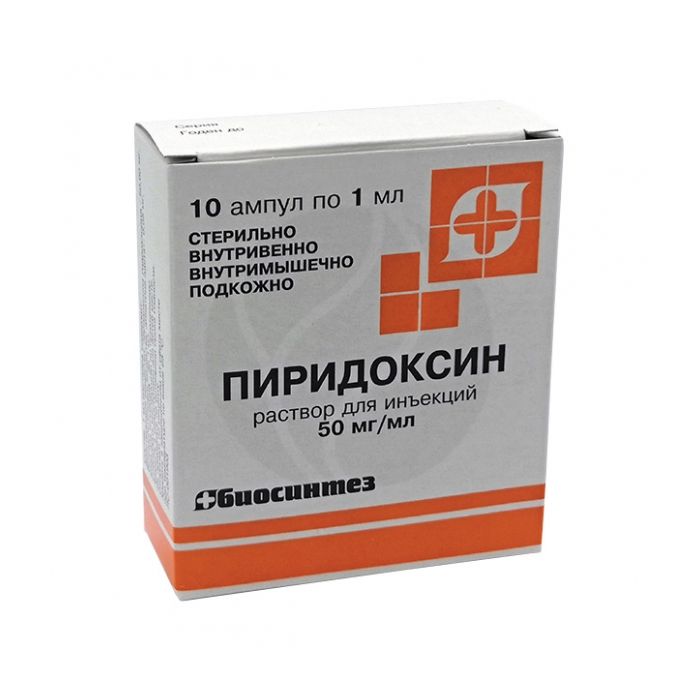Vitamin B6 solution for injection 5%, 1ml No. 10
Expiration Date: 05/2027
Russian Pharmacy name:
Витамин В6 раствор для инъекций 5%, 1мл №10
B6 hypovitaminosis,
toxicosis of pregnant women,
sideroblastic anemia,
leukopenia,
diseases of the central nervous system (parkinsonism, chorea minor, Little's disease, radiculitis, neuritis, neuralgia, Meniere's disease),
sea ??and air sickness,
atherosclerosis,
diabetes,
seborrheic and non-seborrheic dermatitis,
herpes zoster
neurodermatitis,
psoriasis,
exudative diathesis,
the use of drugs of the isoniazid group.
Subcutaneously, intramuscularly and intravenously.
Adults are usually prescribed 0.05-0.1 g per day in 1-2 doses, children 0.02 g. The course of treatment for adults is 1 month, for children 2 weeks. For the treatment of sideroblastic anemia - 0.1 g intramuscularly 2 times a week. It is advisable to simultaneously take folic acid, cyanocobalamin, riboflavin.
With parkinsonism - 2 ml of 5% solution per day intramuscularly. The course of treatment is 20-25 injections. After 2-3 months, the course is repeated.
With depressions of involutional age, 0.2 g per day is administered intramuscularly.
1 ampoule (1 ml) contains: pyridoxine hydrochloride 50 mg, water for injection up to 1 ml.
Hypersensitivity.
Carefully:
peptic ulcer of the stomach and duodenum.
Composition
1 ampoule (1 ml) contains: pyridoxine hydrochloride 50 mg, water for injection up to 1 ml.
pharmachologic effect
Pyridoxine hydrochloride - vitamin B6. It is phosphorylated and in the form of pyridoxal phosphate is a part of enzymes that catalyze decarboxylation and transamination. Plays an important role in the metabolism of tryptophan, glutamic acid, cysteine, methionine, as well as in the transport of amino acids across the cell membrane. It is necessary for the activation of phosphorylase, for the formation of neurotransmitters, gamma-aminobutyric acid, glycine, serotonin. Participates in the exchange of vitamin B12, folic acid, in the synthesis of porphyrins, in the exchange of unsaturated fatty acids. It is used to activate metabolic processes in myofibrils, especially with myocardial hypoxia. The daily requirement for adults is 2Ц2.5 mg, for children from 6 months to 1 year - 0.5 mg, 1Ц1.5 years old - 0.9 mg, 1.5Ц2 years old - 1 mg, 3Ц 4 years old - 1.3 mg, 5-6 years old - 1.4 mg, 7-10 years old - 1.7 mg, 11-13 years old - 2 mg,for boys 14-17 years old - 2.2 mg, for girls 14-17 years old - 1.9 mg.
Indications
B6 hypovitaminosis,
toxicosis of pregnant women,
sideroblastic anemia,
leukopenia,
diseases of the central nervous system (parkinsonism, chorea minor, Little's disease, radiculitis, neuritis, neuralgia, Meniere's disease),
sea ??and air sickness,
atherosclerosis,
diabetes,
seborrheic and non-seborrheic dermatitis,
herpes zoster
neurodermatitis,
psoriasis,
exudative diathesis,
the use of drugs of the isoniazid group.
Contraindications
Hypersensitivity.
Carefully:
peptic ulcer of the stomach and duodenum.
Method of administration and dosage
Subcutaneously, intramuscularly and intravenously.
Adults are usually prescribed 0.05-0.1 g per day in 1-2 doses, children 0.02 g.
The course of treatment for adults is 1 month, for children 2 weeks.
For the treatment of sideroblastic anemia - 0.1 g intramuscularly 2 times a week.
It is advisable to simultaneously take folic acid, cyanocobalamin, riboflavin.
With parkinsonism - 2 ml of 5% solution per day intramuscularly. The course of treatment is 20-25 injections. After 2-3 months, the course is repeated. With depressions of involutional age, 0.2 g per day is administered intramuscularly.
Side effects
Allergic reactions, increased gastric acidity.
Drug interactions
The effect is reduced by isoniazid, cycloserine, penicillamine. Pharmaceutical incompatible with vitamins B1 and B12. Weakens the antiparkinsonian activity of levodopa.
Storage conditions
In a dark place.

